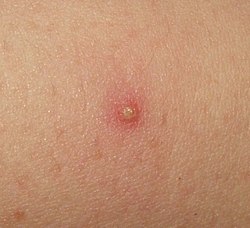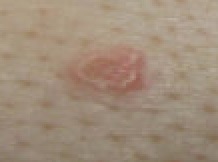| Folliculitis | |
|---|---|
 | |
| Folliculitis, single lesion | |
| Specialty | Dermatology |
Folliculitis is the infection and inflammation of one or more hair follicles. The condition may occur anywhere on hair-covered skin. The rash may appear as pimples that come to white tips on the face, chest, back, arms, legs, buttocks, or head. [1]
Contents
- Signs and symptoms
- Complications
- Causes
- Bacterial
- Fungal
- Mites
- Viral
- Noninfectious
- Treatment
- See also
- References
- External links
Although acne can often involve superficial infection and inflammation of some hair follicles, the condition of those follicles is usually not called folliculitis, as that term is usually reserved for the separate set of disease entities comprising infected and inflamed hair follicles with causes other than acne.

